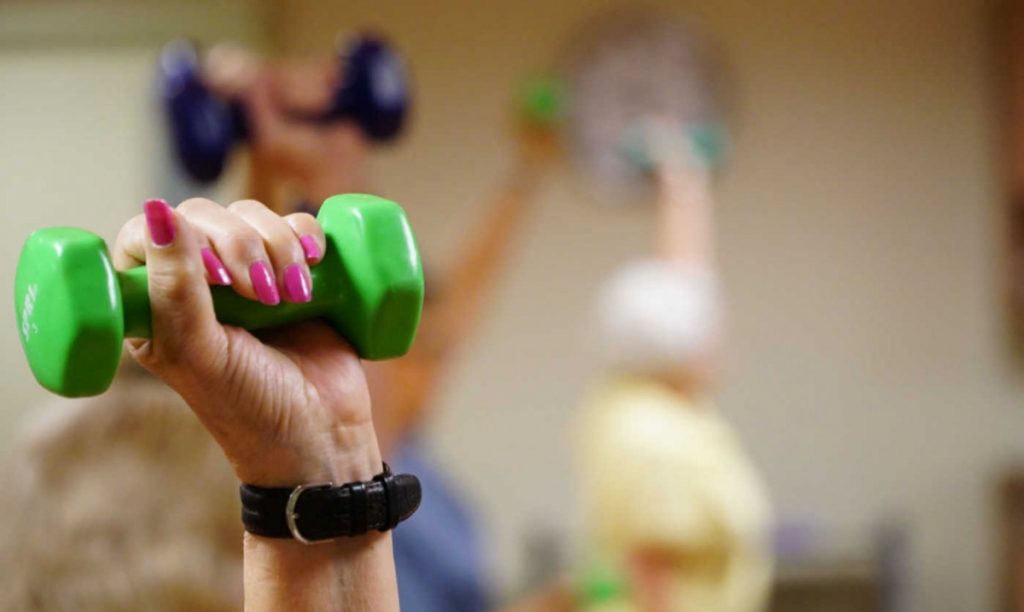Simple Exercises Can Improve Quality of Life for Older Adults.
“Functional fitness,” like most buzzwords, means something a little different to everyone who uses it.
But when you look at the day-to-day challenges many older adults face, the concept becomes much more concrete. According to the Centers for Disease Control and Prevention, 61 percent of adults ages 65 and older are limited in their ability to perform basic actions, such as picking something up off the floor or reaching to grab a cereal box from the pantry.
Functional-fitness exercises are designed to train and develop your muscles to make it easier and safer to perform everyday tasks, such as bathing, dressing, getting out of bed, shopping, and driving. As you build strength, activities of daily living become easier to complete.
The National Institutes of Health recommend functional-fitness exercises that support four fitness goals: endurance, strength, balance, and flexibility. The good news is many exercises address all four goals at once. Plus, many exercises can be incorporated into your daily routine:
- Walking. Walking is a fantastic exercise for seniors—or anyone, really. Walking strengthens major muscle groups and supports endurance, balance, and flexibility. It also can be done anywhere! Take a walk around your neighborhood or go to the mall. Bring a friend or walk alone, and try to walk every day, even if for 10 minutes at a time.
- Climbing stairs. This everyday activity is great exercise. Climbing stairs strengthens your legs, maintains flexibility in the hip and knee joints, and builds or maintains cardiac endurance. If stairs aren’t readily available for you to use, skip the elevator the next time you visit the doctor, a friend, or the mall, and take the stairs instead.
- Sit to stand. Otherwise known as a chair squat, this exercise is easy to do. Every time you sit down to eat, play cards, read a book, or watch TV, begin by standing in front of your chair, then sit as you normally would. However, before your bottom actually touches the chair, stand up again. Repeat several times.
- Wall pushups. A great way to improve your upper body strength. Stand slightly less than arm’s length from the wall, close enough to place your palms flat on the wall. Keeping your body straight, bend your elbows and lean forward toward the wall. Press away from the wall back to your starting position. The closer you are to the wall, the easier the exercise. Start closer and work yourself farther away as you’re able.
Stronger muscles, better balance, more flexibility. The physical benefits of exercise are clear. But did you know there are emotional benefits to functional fitness, as well?
While you can work out alone, many physical activities involve some sort of social interaction, even if it’s just saying “hello” as you pass someone on the same walking path. Social engagement, however brief, may boost your immune system and your mood—contributing to an overall sense of well-being and happiness. (One more reason to try that group exercise class!)
Staying physically fit can increase your self-confidence. Knowing you’re able to manage daily activities, such as playing with your grandchild or unloading groceries from the car, is important to help maintain a positive attitude.
Moreover, when you’re fit and confident, you can rely on your own independence. Feelings of strength and independence ensure you have control over your own life situation, even as changes arise. And as we all know, aging brings with it many changes!
It’s easy to make excuses not to start a new fitness routine. But the benefits are so great that it makes sense to bite the bullet and start today! It’s never too late to start taking better care of your body and your mind.
(As with any new exercise, check with your doctor before beginning a functional-fitness program.)
Laura Smith is the enrichment center assistant administrator at SourcePoint. This article was also published in the Delaware Gazette.

